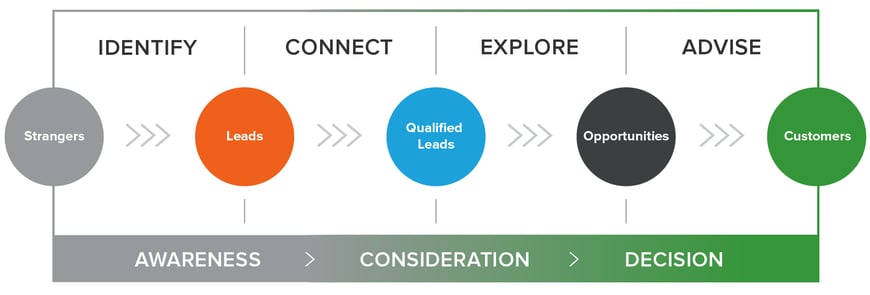Six sales techniques that will help you build a mutually beneficial, lasting relationship with your prospects and ultimately win their business.
Cold outreach is impersonal, costly and not particularly effective. You can’t approach selling with a one size fits all, cookie-cutter strategy and expect prospects to be lining up to hear your sales pitch. Many salespeople forget the importance of connecting with their leads on a personal level and, in their eagerness to turn an Marketing Qualified Lead (MQL) into a hot opportunity, end up coming across too forceful, irritating and even a little bit creepy at times.
Inbound sales, on the other hand, is all about personalisation. It supports potential buyers through the process of the buyer’s journey (the path to purchase) from awareness, to consideration and finally to making a decision. The inbound sales methodology consists of four key stages; identify, connect, explore and advise.

Image source: HubSpot
- Identify
Knowing how to identify the right business opportunities can go a long way towards building a successful business. Talk to existing customers to help you understand what drove their purchase, and use this information to begin building buyer personas (semi-fictional representations of your ideal customer). Knowing your buyer personas will help you tailor your message to address their specific pain points, goals and challenges.
- Connect
During the connect phase, inbound salespeople need to reach out to prospects and try to understand more about them and their background, in an effort to understand the context that lead to their need for a solution to their problem.
- Explore
Once you’ve determined your prospect’s goals, challenges and pain points, you need to explore ways that your product or service could address these needs and whether you think the relationship is a good fit. If it’s not a good fit, don’t be afraid to say so - it’s better to be honest upfront than to land up with a dissatisfied customer down the line. Just like happy customers can be your greatest evangelists, unhappy customers can spread the word that your brand didn’t live up to their expectations.
- Advise
The key to successful inbound sales is building lasting, mutually beneficial relationships. According to HubSpot, “inbound salespeople advise prospects on why their solution is uniquely positioned to address the buyer’s needs”.
HubSpot, marketing and sales software developer, drew the following comparison between legacy (traditional) and inbound sales:
.png?width=870&height=506&name=inbound-sales-versus-legacy-sales%20(1).png)
Here are six inbound sales techniques that will help you to connect with your prospect and get to know more about them in a way that respects their boundaries and builds a lasting, mutually beneficial relationship.
- Starting the relationship on the right foot
You’ll never get a second chance to make a first impression, so make sure it’s a good one.
- Don’t be creepy
You can tell the prospect you received their information from a form they submitted but don’t go into detail about your marketing or tracking tools.
- Be empathetic
When contacting a prospect, put yourself in their shoes by asking yourself if you’re interrupting them, what you could be interrupting and how you would react to a call at this time.
- Add value
Instead of asking a prospect for a minute of their time (the typical opening line for salespeople), rather ask your prospect for permission to ask a few questions to understand their needs.
- Creating awareness of the current situation
Your lead has no idea that your marketing department has been monitoring their online activity to determine whether they’re a qualified lead, so begin your conversation with a few key questions to reaffirm that which you already know. Keep your questions simple and easy to answer and make sure that you’re able to understand the prospect’s needs. You should only ask questions that are relevant and can be used later on in the sales process.
- Exploring goals, pain points and challenges
Once you’ve gathered some background information from your prospect, you need to help the prospect identify their pain points and establish a need for a solution. This conversation is not about punting your product it’s about reconnaissance. Don’t make the mistake of trying to push your product as a solution just yet - just focus on helping the customer to identify and clarify the problems that your company can help them solve.
The inbound marketing and sales methodology covers every point of interaction between your brand and your potential buyers from stranger all the way through to happy customer. It’s a long and in depth process, but there’s no denying that inbound delivers results.
If you’d like to find out more about the benefits of aligning sales and marketing - get our guide to navigating  and see how qualifying leads can help your sales and marketing teams.
and see how qualifying leads can help your sales and marketing teams.
